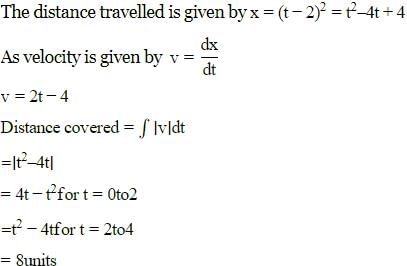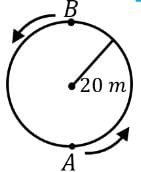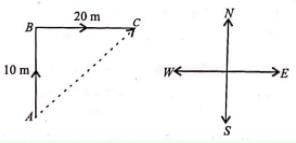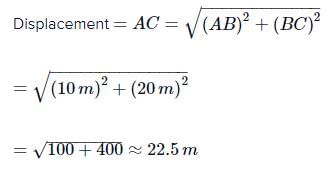All Exams >
SSS 2 >
Physics for SSS 2 >
All Questions
All questions of Position, Distance and Displacement for SSS 2 Exam
A man starts from his home with a speed of 4 km/h on a straight road up to his office 5 km away and returns to home, then the path length covered is:
- a)-5 km
- b)5 km
- c)0
- d)10 km
Correct answer is option 'D'. Can you explain this answer?
A man starts from his home with a speed of 4 km/h on a straight road up to his office 5 km away and returns to home, then the path length covered is:
a)
-5 km
b)
5 km
c)
0
d)
10 km
|
|
Preeti Khanna answered |
5 km is the distance covered while going and 5 km while coming back.
⇒ Total path travelled = 10 km
⇒ Total path travelled = 10 km
The ratio of magnitude of velocity and speed is always:- a)Equal to or less than one
- b)Less than one
- c)One
- d)Equal to or greater than one
Correct answer is option 'A'. Can you explain this answer?
The ratio of magnitude of velocity and speed is always:
a)
Equal to or less than one
b)
Less than one
c)
One
d)
Equal to or greater than one
|
|
Anjana Sharma answered |
The displacement of the body in given time is always equal to or less than distance covered, because, velocity is displacement per unit time and speed is distance covered per unit time, therefore, ratio of magnitude of velocity and speed is always equal to or less than one.
A particle is moving along a circle of radius R such that it completes one revolution in 40 seconds. What will be the displacement after 2 minutes 20 seconds?
- a)6R
- b)2R
- c)4R
- d)R
Correct answer is option 'B'. Can you explain this answer?
A particle is moving along a circle of radius R such that it completes one revolution in 40 seconds. What will be the displacement after 2 minutes 20 seconds?
a)
6R
b)
2R
c)
4R
d)
R
|
|
Nandini Patel answered |
1 revolution in 40 seconds
In 1 second it covers = 1/40 revolution
In 140 sec = 1/40 * 140 =7/2 rotation = 3 and half rotation
In 1 second it covers = 1/40 revolution
In 140 sec = 1/40 * 140 =7/2 rotation = 3 and half rotation
Then the particle will be on the diametrically opposite end.
Therefore, Displacement = R + R = 2R
Which of the following is not an example of a rectilinear motion?
- a)A car moving on a straight road.
- b)A rain drop falling towards the earth.
- c)A car moving in a circular path.
- d)A wooden block sliding down the inclined plane.
Correct answer is option 'A'. Can you explain this answer?
Which of the following is not an example of a rectilinear motion?
a)
A car moving on a straight road.
b)
A rain drop falling towards the earth.
c)
A car moving in a circular path.
d)
A wooden block sliding down the inclined plane.
|
|
Neha Joshi answered |
Rectilinear motion is another name for straight-line motion.
A body is said to experience rectilinear motion if any two particles of the body travel the same distance along two parallel straight lines.
A body is said to experience rectilinear motion if any two particles of the body travel the same distance along two parallel straight lines.
A car moving in a circular path changes its direction at every instant. Thus, it is not the rectilinear motion.
36 km/h is equal to:
- a)129. 6 ms-1
- b)600 ms-1
- c)10 ms-1
- d)12.96 ms-1
Correct answer is option 'C'. Can you explain this answer?
36 km/h is equal to:
a)
129. 6 ms-1
b)
600 ms-1
c)
10 ms-1
d)
12.96 ms-1
|
|
Geetika Shah answered |
1 km = 1000 m and 1 hr = 3600 sec.
Therefore,

If a body does not change its direction during the course of its motion, then ______.
- a)Displacement is greater than path length.
- b)Path length and displacement are equal.
- c)Path length is greater than displacement.
- d)Path length is either greater or equal to displacement.
Correct answer is option 'B'. Can you explain this answer?
If a body does not change its direction during the course of its motion, then ______.
a)
Displacement is greater than path length.
b)
Path length and displacement are equal.
c)
Path length is greater than displacement.
d)
Path length is either greater or equal to displacement.
|
|
Rajeev Saxena answered |
Since the object does not change its direction it means that the object is traveling in a straight line.
⇒ The path length and displacement will be equal.
⇒ The path length and displacement will be equal.
The numerical ratio of velocity to speed is:- a)Either less than or equal to 1
- b)Equal to 1
- c)Greater than 1
- d)Less than 1
Correct answer is option 'A'. Can you explain this answer?
The numerical ratio of velocity to speed is:
a)
Either less than or equal to 1
b)
Equal to 1
c)
Greater than 1
d)
Less than 1
|
|
Charvi Mehta answered |
When an object is moving along a straight path, magnitude of average velocity is equal to the average speed. Therefore, numerical ratio of average velocity to average speed is one in a straight line motion.
But, during curved motion, the displacement<distance covered, so the velocity<speed.
A vehicle travels half the distance L with speed V1and the other half with speed V2, then its average speed is
- a)

- b)

- c)

- d)

Correct answer is option 'C'. Can you explain this answer?
A vehicle travels half the distance L with speed V1and the other half with speed V2, then its average speed is
a)

b)

c)

d)

|
|
Gaurav Kumar answered |
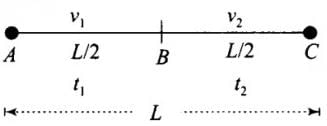
Let the vehicle travels from A to B. Distances, velocities, and time taken are shown. To calculate average speed we will calculate the total distance covered and will divide it by the time interval in which it covers that total distance.
Time taken to travel first half distance t1
Time taken to travel first half distance t1

Time taken to travel first half distance t1

Total time taken = t1 + t2

We know that vav = Average speed = Total Distance / Total Time




A car covers a distance of 5 km in 5 mins, its average speed is equal to- a)1 km ⁄ h
- b)25 km ⁄ h
- c)60 km ⁄ h
- d)None of the above
Correct answer is option 'C'. Can you explain this answer?
A car covers a distance of 5 km in 5 mins, its average speed is equal to
a)
1 km ⁄ h
b)
25 km ⁄ h
c)
60 km ⁄ h
d)
None of the above
|
|
Raghav Bansal answered |
5 km in 5 mins, which means 1 km in 1 min
Hence, it will travel 60 km in 60 mins, i.e. speed = 60km/hr
Hence, it will travel 60 km in 60 mins, i.e. speed = 60km/hr
The ratio of displacement to distance is- a)Greater than 1
- b)Either less than or equal to 1
- c)Less than 1
- d)Equal to 1
Correct answer is option 'B'. Can you explain this answer?
The ratio of displacement to distance is
a)
Greater than 1
b)
Either less than or equal to 1
c)
Less than 1
d)
Equal to 1
|
|
Saumya Dey answered |
Ratio of Displacement to Distance
Displacement and distance are two terms used in physics to describe the motion of an object. Displacement refers to the change in position of an object from its initial to final position, whereas distance refers to the total path covered by the object during its motion.
Ratio of Displacement to Distance Formula
The ratio of displacement to distance is given by:
Displacement / Distance
This ratio is used to determine the efficiency of an object's motion. If the ratio is equal to 1, it means that the object has moved in a straight line from its initial to final position. If the ratio is less than 1, it means that the object has taken a longer path to reach its final position, and if the ratio is greater than 1, it means that the object has moved back and forth before reaching its final position.
Answer Explanation
The correct answer to the question is option B, which states that the ratio of displacement to distance is either less than or equal to 1. This is because an object can never cover a greater distance than its displacement. The displacement represents the shortest distance between the initial and final positions of an object, whereas the distance represents the total path covered by the object.
Therefore, the displacement can be equal to or less than the distance covered by the object, but it can never be greater than the distance. This is the reason why the ratio of displacement to distance is either less than or equal to 1.
Displacement and distance are two terms used in physics to describe the motion of an object. Displacement refers to the change in position of an object from its initial to final position, whereas distance refers to the total path covered by the object during its motion.
Ratio of Displacement to Distance Formula
The ratio of displacement to distance is given by:
Displacement / Distance
This ratio is used to determine the efficiency of an object's motion. If the ratio is equal to 1, it means that the object has moved in a straight line from its initial to final position. If the ratio is less than 1, it means that the object has taken a longer path to reach its final position, and if the ratio is greater than 1, it means that the object has moved back and forth before reaching its final position.
Answer Explanation
The correct answer to the question is option B, which states that the ratio of displacement to distance is either less than or equal to 1. This is because an object can never cover a greater distance than its displacement. The displacement represents the shortest distance between the initial and final positions of an object, whereas the distance represents the total path covered by the object.
Therefore, the displacement can be equal to or less than the distance covered by the object, but it can never be greater than the distance. This is the reason why the ratio of displacement to distance is either less than or equal to 1.
Suppose our school is 1 km away from our house, and we go to school in the morning, and in the afternoon we come back. Then, the total displacement for the entire trip is- a)1 km
- b)2 km
- c)-1 km
- d)0 km
Correct answer is option 'D'. Can you explain this answer?
Suppose our school is 1 km away from our house, and we go to school in the morning, and in the afternoon we come back. Then, the total displacement for the entire trip is
a)
1 km
b)
2 km
c)
-1 km
d)
0 km
|
|
Lavanya Menon answered |
The displacement is 0 because the initial and final position are the same, i.e. the home, and hence, displacement is 0.
Jagadeesh, on driving his way to school, calculates the speed for the trip to be 20 km/hr. After reaching the school he found the school was closed. So he immediately started returning home. While on his return trip, due to less traffic, he calculates the speed to be 40 km/hr. Calculate Jagadeesh's average speed for the entire journey.
- a)26.67 kmhr-1
- b)33.34 kmhr-1
- c)50 kmhr-1
- d)30 kmhr-1
Correct answer is option 'A'. Can you explain this answer?
Jagadeesh, on driving his way to school, calculates the speed for the trip to be 20 km/hr. After reaching the school he found the school was closed. So he immediately started returning home. While on his return trip, due to less traffic, he calculates the speed to be 40 km/hr. Calculate Jagadeesh's average speed for the entire journey.
a)
26.67 kmhr-1
b)
33.34 kmhr-1
c)
50 kmhr-1
d)
30 kmhr-1

|
Ciel Knowledge answered |
Let t1 and t2 be the time taken for Jagadeesh to go to school and then back home. If s is the displacement, then

Total time taken

Total displacement=2 s


Total time taken

Total displacement=2 s

Two escalators move people up and down between floors of a shopping mall at the same rate, either up or down. What of the following statements regarding the motion of the escalators is true?- a)The escalators have different speeds and velocities.
- b)The escalators have the same velocity, but different speeds.
- c)The escalators have the same speed and velocity.
- d)The escalators have the same speed, but different velocities.
Correct answer is option 'D'. Can you explain this answer?
Two escalators move people up and down between floors of a shopping mall at the same rate, either up or down. What of the following statements regarding the motion of the escalators is true?
a)
The escalators have different speeds and velocities.
b)
The escalators have the same velocity, but different speeds.
c)
The escalators have the same speed and velocity.
d)
The escalators have the same speed, but different velocities.
|
|
Riya Banerjee answered |
As the particles are moving at the same rate, their speed is the same but velocities will be different beacuse their directions will be different.
Which of the following statements is incorrect?- a)Displacement is independent of the choice of origin of the axis.
- b)Displacement may or may not be equal to the distance travelled.
- c)When a particle returns to its starting point, its displacement is not zero.
- d)Displacement does not tell the nature of the actual motion of a particle between the points.
Correct answer is option 'C'. Can you explain this answer?
Which of the following statements is incorrect?
a)
Displacement is independent of the choice of origin of the axis.
b)
Displacement may or may not be equal to the distance travelled.
c)
When a particle returns to its starting point, its displacement is not zero.
d)
Displacement does not tell the nature of the actual motion of a particle between the points.
|
|
Dev Patel answered |
When a particle returns to it's initial position, Initial and final positions will be same therefore net displacement of the particle is zero. Hence the given statement is false.
Which of the following statements is incorrect?- a)Path length is a scalar quantity whereas displacement is a vector quantity.
- b)The magnitude of displacement is always equal to the path length traversed by an object over a given time interval.
- c)The displacement depends only on the end points whereas path length depends on the actual path followed.
- d)The path length is always positive whereas displacement can be positive, negative and zero.
Correct answer is option 'B'. Can you explain this answer?
Which of the following statements is incorrect?
a)
Path length is a scalar quantity whereas displacement is a vector quantity.
b)
The magnitude of displacement is always equal to the path length traversed by an object over a given time interval.
c)
The displacement depends only on the end points whereas path length depends on the actual path followed.
d)
The path length is always positive whereas displacement can be positive, negative and zero.
|
|
Jyoti Sengupta answered |
In one dimensional motion, the path length and magnitude of displacement are equal only if the object does not change its direction during the course of motion. In all other cases, the path length is greater than the magnitude of displacement.
A car travels first half of the displacement between two places with a velocity of 40 km/hr and the second half at 60 km/hr. Calculate the average velocity for the entire journey.
- a)48 kmhr-1
- b)30 kmhr-1
- c)26.67 kmhr-1
- d)40 kmhr-1
Correct answer is option 'A'. Can you explain this answer?
A car travels first half of the displacement between two places with a velocity of 40 km/hr and the second half at 60 km/hr. Calculate the average velocity for the entire journey.
a)
48 kmhr-1
b)
30 kmhr-1
c)
26.67 kmhr-1
d)
40 kmhr-1

|
Imk Pathsala answered |
Given,
v1=40 km/hr and v2=60 km/hr.
The average velocity when the car covers equal displacements would be,



The slope of velocity-time graph for motion with uniform velocity is equal to:- a)Zero
- b)Final velocity
- c)Initial velocity
- d)Infinite
Correct answer is option 'A'. Can you explain this answer?
The slope of velocity-time graph for motion with uniform velocity is equal to:
a)
Zero
b)
Final velocity
c)
Initial velocity
d)
Infinite

|
Shiksha Academy answered |
When velocity is uniform, velocity-time graph is straight line parallel to time axis. So, the slope is zero.
A drunkard is walking along a straight road. He takes 5 steps forward and 3 steps backward and so on. Each step is 1m long and takes 1s. There is a pit on the road 11 m away from the starting point. The drunkard will fall into the pit after:- a)21 s
- b)29 s
- c)31 s
- d)37 s
Correct answer is option 'B'. Can you explain this answer?
A drunkard is walking along a straight road. He takes 5 steps forward and 3 steps backward and so on. Each step is 1m long and takes 1s. There is a pit on the road 11 m away from the starting point. The drunkard will fall into the pit after:
a)
21 s
b)
29 s
c)
31 s
d)
37 s
|
|
Geetika Shah answered |
Displacement in first eight steps = (5 - 3) m = 2 m
Time taken for first eight steps = 8 s
Time taken by the drunkard to cover first 6 m of journey = 8/2 * 6 = 24 s
If the drunkard takes 5 steps more, he will fall into the pit. So the time taken by the drunkard to cover last five steps = 5 s
Total time taken = 24 s + 5 s = 29 s
The location of a particle is changed. What can we say about the displacement and distance covered by the particle?- a)Both cannot be zero
- b)One of the two may be zero
- c)Both must be zero
- d)Both must be equal
Correct answer is option 'B'. Can you explain this answer?
The location of a particle is changed. What can we say about the displacement and distance covered by the particle?
a)
Both cannot be zero
b)
One of the two may be zero
c)
Both must be zero
d)
Both must be equal
|
|
Shreya Menon answered |
Understanding Displacement and Distance
Displacement and distance are two fundamental concepts in physics that describe motion. Here's a detailed explanation of their relationship when a particle's location changes.
Definition of Distance
- Distance is a scalar quantity that refers to the total path length traveled by a particle, regardless of direction.
- It can never be negative and is always equal to or greater than zero.
Definition of Displacement
- Displacement is a vector quantity that represents the change in position of a particle.
- It considers both magnitude and direction, calculated as the straight-line distance between the initial and final positions.
Possible Scenarios
- Both Displacement and Distance Cannot Be Zero
- This is false. If a particle does not move, both displacement and distance are zero.
- One of the Two May Be Zero
- This is true. If the particle returns to its initial position, the displacement is zero, but the distance traveled is the total length of the path taken.
- Both Must Be Equal
- This is false in general. They are equal only when the motion is in a straight line without any deviation.
- Both Must Be Zero
- This is false. They are zero only when there is no movement at all.
Conclusion
In summary, the correct answer is option 'B': One of the two may be zero. When analyzing a particle's motion, it's crucial to understand that while distance can vary, displacement may become zero when the particle returns to its starting point. This illustrates the distinct nature of these two concepts in physics.
Displacement and distance are two fundamental concepts in physics that describe motion. Here's a detailed explanation of their relationship when a particle's location changes.
Definition of Distance
- Distance is a scalar quantity that refers to the total path length traveled by a particle, regardless of direction.
- It can never be negative and is always equal to or greater than zero.
Definition of Displacement
- Displacement is a vector quantity that represents the change in position of a particle.
- It considers both magnitude and direction, calculated as the straight-line distance between the initial and final positions.
Possible Scenarios
- Both Displacement and Distance Cannot Be Zero
- This is false. If a particle does not move, both displacement and distance are zero.
- One of the Two May Be Zero
- This is true. If the particle returns to its initial position, the displacement is zero, but the distance traveled is the total length of the path taken.
- Both Must Be Equal
- This is false in general. They are equal only when the motion is in a straight line without any deviation.
- Both Must Be Zero
- This is false. They are zero only when there is no movement at all.
Conclusion
In summary, the correct answer is option 'B': One of the two may be zero. When analyzing a particle's motion, it's crucial to understand that while distance can vary, displacement may become zero when the particle returns to its starting point. This illustrates the distinct nature of these two concepts in physics.
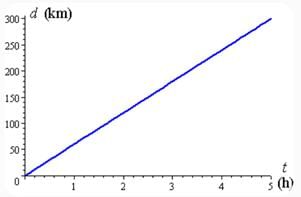 An upward, straight sloping line (left to right) on a distance time graph means:-
An upward, straight sloping line (left to right) on a distance time graph means:-- a)Speeding up
- b)Constant Speed
- c)Slowing down
- d)None of these
Correct answer is option 'B'. Can you explain this answer?

An upward, straight sloping line (left to right) on a distance time graph means:-
a)
Speeding up
b)
Constant Speed
c)
Slowing down
d)
None of these

|
Mohit Rajpoot answered |
A distance-time graph with a straight line sloping upwards indicates that the distance is increasing at a uniform rate over time. This means the object is covering equal distances in equal intervals of time, which is the definition of constant speed.
Chapter doubts & questions for Position, Distance and Displacement - Physics for SSS 2 2025 is part of SSS 2 exam preparation. The chapters have been prepared according to the SSS 2 exam syllabus. The Chapter doubts & questions, notes, tests & MCQs are made for SSS 2 2025 Exam. Find important definitions, questions, notes, meanings, examples, exercises, MCQs and online tests here.
Chapter doubts & questions of Position, Distance and Displacement - Physics for SSS 2 in English & Hindi are available as part of SSS 2 exam.
Download more important topics, notes, lectures and mock test series for SSS 2 Exam by signing up for free.
Physics for SSS 2
118 docs|22 tests
|

Contact Support
Our team is online on weekdays between 10 AM - 7 PM
Typical reply within 3 hours
|
Free Exam Preparation
at your Fingertips!
Access Free Study Material - Test Series, Structured Courses, Free Videos & Study Notes and Prepare for Your Exam With Ease

 Join the 10M+ students on EduRev
Join the 10M+ students on EduRev
|

|
Create your account for free
OR
Forgot Password
OR
Signup to see your scores
go up
within 7 days!
within 7 days!
Takes less than 10 seconds to signup

